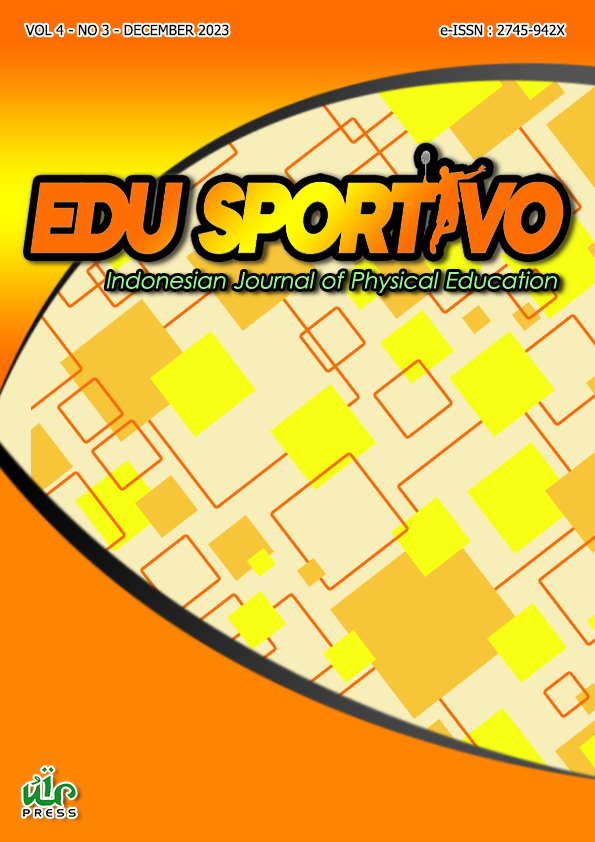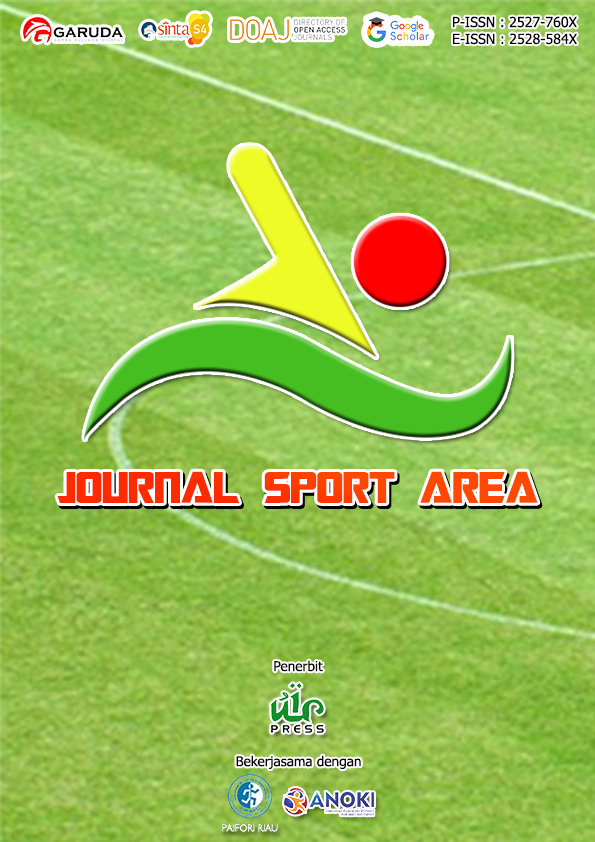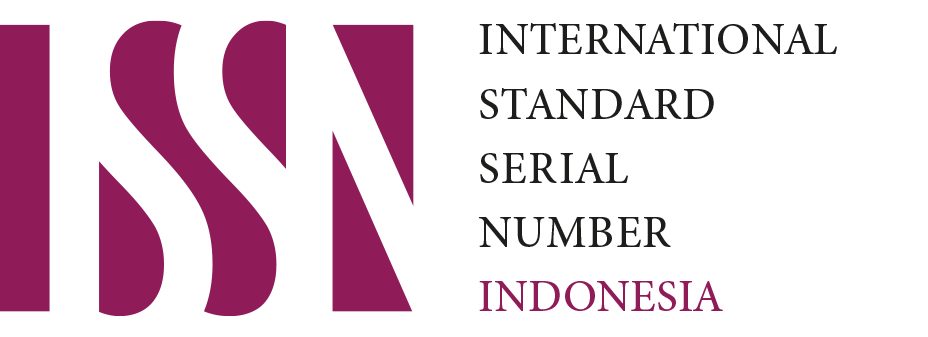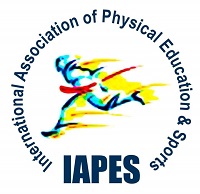Unleashing the potential of blended learning: An in-depth investigation in Indonesia and Malaysia
Keywords:
Teachers perspective, blended learning, physical educationAbstract
A limited literature on mixed method research to reveal the effect of blended learning in physical education turn out to be a gap in this research. Therefore, our study aims to investigate the perceptions of teachers about the effects, effectiveness, and challenges of blended learning in physical education classes through mixed-methods research. This study adopted a mixed-methods type with a mixed methods research. There were 12 participants involved in this study, which included elementary school teachers (n=4) and high school teachers (n=4) from Indonesia and elementary school teachers (n=2) and high school teachers (n=2) from Malaysia. The qualitative instrument included in-depth interviews. While, the quantitative instrument used a questionnaire. The qualitative study used statistical analysis with qualitative thematic methods. Meanwhile, in the quantitative study, all responses from 12 analyses were to find the frequency and percentage values of each response. Based on the results of the qualitative study, the majority of teachers perceived that blended learning in physical education classes had a significant effect on the development of students' domains and it was effective to implement physical education learning in elementary schools and high schools. While, results of quantitative study show that the biggest challenges due to the implementation of blended learning in physical education were the lack of technological facilities (86.2%), lack of understanding of teachers and students (72.7%), poor internet connection (64.8%), and limited learning duration in offline classes (50.0%). Therefore, the results of this study are essential and must be evaluated continuously, so that the physical education learning process through blended learning in a sustainable manner can have a positive effect on students at all levels of education in Indonesia and Malaysia or other countries in the world.
Downloads
References
Almendingen, K., Morseth, M. S., Gjølstad, E., Brevik, A., & Tørris, C. (2021). Student’s experiences with online teaching following COVID-19 lockdown: A mixed methods explorative study. PloS One, 16(8), e0250378. https://doi.org/10.1371/journal.pone.0250378 DOI: https://doi.org/10.1371/journal.pone.0250378
Almonacid-fierro, A., Vargas-vitoria, R., Carvalho, R. S. De, & Vargas-vitoria, R. (2021). Impact on teaching in times of COVID-19 pandemic : A qualitative study. International Journal of Evaluation and Research in Education, 10(2), 432–440. https://doi.org/10.11591/ijere.v10i2.21129 DOI: https://doi.org/10.11591/ijere.v10i2.21129
Amenduni, F., & Ligorio, M. B. (2022). Blended Learning and Teaching in Higher Education: An International Perspective. Education Sciences, 12(2), 10–12. https://doi.org/10.3390/educsci12020129 DOI: https://doi.org/10.3390/educsci12020129
André, M., Vidoni, C., & Fitzgerald, H. (2021). Blended professional development in physical education: Merging long-distance with face-to-face ongoing support. Journal of Physical Education and Sport, 21(2), 956–965. https://doi.org/10.7752/jpes.2021.02119 DOI: https://doi.org/10.7752/jpes.2021.02119
Ashraf, M. A., Mollah, S., Perveen, S., Shabnam, N., & Nahar, L. (2022). Pedagogical Applications, Prospects, and Challenges of Blended Learning in Chinese Higher Education: A Systematic Review. Frontiers in Psychology, 12. 1-13. https://doi.org/10.3389/fpsyg.2021.772322 DOI: https://doi.org/10.3389/fpsyg.2021.772322
Ashraf, M. A., Yang, M., Zhang, Y., Denden, M., Tlili, A., Liu, J., Huang, R., & Burgos, D. (2021). A systematic review of systematic reviews on blended learning: Trends, gaps and future directions. Psychology Research and Behavior Management, 14(October), 1525–1541. https://doi.org/10.2147/PRBM.S331741 DOI: https://doi.org/10.2147/PRBM.S331741
Bayyat, M. (2020). Blended Learning: a New Approach To Teach Ballet Technique for Undergraduate Students. Turkish Online Journal of Distance Education, 21(2), 69–86. https://doi.org/10.17718/tojde.727979 DOI: https://doi.org/10.17718/tojde.727979
Blain, D. O., Standage, M., & Curran, T. (2022). Physical education in a post-COVID world: A blended-gamified approach. European Physical Education Review, 28(3), 757–776. https://doi.org/10.1177/1356336X221080372 DOI: https://doi.org/10.1177/1356336X221080372
Blaine, A. M. (2019). Interaction and presence in the virtual classroom: An analysis of the perceptions of students and teachers in online and blended Advanced Placement courses. Computers and Education, 132, 31–43. https://doi.org/10.1016/j.compedu.2019.01.004 DOI: https://doi.org/10.1016/j.compedu.2019.01.004
Calderón, A., Scanlon, D., MacPhail, A., & Moody, B. (2021). An integrated blended learning approach for physical education teacher education programmes: teacher educators’ and pre-service teachers’ experiences. Physical Education and Sport Pedagogy, 26(6), 562–577. https://doi.org/10.1080/17408989.2020.1823961 DOI: https://doi.org/10.1080/17408989.2020.1823961
Carrillo, C., & Flores, M. A. (2020). COVID-19 and teacher education: a literature review of online teaching and learning practices. European Journal of Teacher Education, 43(4), 466–487. https://doi.org/10.1080/02619768.2020.1821184 DOI: https://doi.org/10.1080/02619768.2020.1821184
Chan, W. K., Leung, K. I., Hoc, C., Wuc, W., Lam, K. Y., Wong, N. L., Chan, C. Y. R., Leung, K. M., & Tse, A. C. Y. (2021). Effectiveness of online teaching in physical education during covid-19 school closures: A survey study of frontline physical education teachers in Hong Kong. Journal of Physical Education and Sport, 21(4), 1622–1628. https://doi.org/10.7752/jpes.2021.04205 DOI: https://doi.org/10.7752/jpes.2021.04205
Coman, C., Țîru, L. G., Meseșan-Schmitz, L., Stanciu, C., & Bularca, M. C. (2020). Online teaching and learning in higher education during the coronavirus pandemic: Students’ perspective. Sustainability (Switzerland), 12(24), 1–22. https://doi.org/10.3390/su122410367 DOI: https://doi.org/10.3390/su122410367
Faridah, E., Kasih, I., Nugroho, S., & Aji, T. (2022). The Effectiveness of Blended Learning Model on Rhythmic Activity Courses Based on Complementary Work Patterns. International Journal of Education in Mathematics, Science and Technology, 10(4), 918–934. https://doi.org/10.46328/ijemst.2618 DOI: https://doi.org/10.46328/ijemst.2618
Fantiro, F, A., Arifin, B., Muzakki, A., & Setiawan, E. (2022). Blended learning or full online: Increase student mood and motivation during the new normal era. Jurnal SPORTIF : Jurnal Penelitian Pembelajaran, 8(1), 13–28. https://doi.org/10.29407/js_unpgri.v8i1.17507 DOI: https://doi.org/10.29407/js_unpgri.v8i1.17507
Finlay, M. J., Tinnion, D. J., & Simpson, T. (2022). A virtual versus blended learning approach to higher education during the COVID-19 pandemic: The experiences of a sport and exercise science student cohort. Journal of Hospitality, Leisure, Sport and Tourism Education, 30, 100363. https://doi.org/10.1016/j.jhlste.2021.100363 DOI: https://doi.org/10.1016/j.jhlste.2021.100363
Fresen, J. W. (2018). Embracing distance education in a blended learning model: challenges and prospects. Distance Education, 39(2), 224–240. https://doi.org/10.1080/01587919.2018.1457949 DOI: https://doi.org/10.1080/01587919.2018.1457949
Hrastinski, S. (2019). What Do We Mean by Blended Learning? TechTrends, 63(5), 564–569. https://doi.org/10.1007/s11528-019-00375-5 DOI: https://doi.org/10.1007/s11528-019-00375-5
Jeong, H. C., & So, W. Y. (2020). Difficulties of online physical education classes in middle and high school and an efficient operation plan to address them. International Journal of Environmental Research and Public Health, 17(19), 1–13. https://doi.org/10.3390/ijerph17197279 DOI: https://doi.org/10.3390/ijerph17197279
Jumareng, H., Setiawan, E., Asmuddin, A., Rahadian, A., Gazali, N., & Badaruddin, B. (2022). Online Learning for Children with Disabilities During the COVID-19: Investigating Parents’ Perceptions. The Qualitative Report, 27(2), 591–604. https://doi.org/10.46743/2160-3715/2022.4926 DOI: https://doi.org/10.46743/2160-3715/2022.4926
Jumareng, H., Setiawan, E., Patah, I. A., Aryani, M., Asmuddin, A., & Gani, R. A. (2021). Online Learning and Platforms Favored in Physical Education Class during COVID-19 Era: Exploring Student’ Perceptions. International Journal of Human Movement and Sports Sciences, 9(1), 11–18. https://doi.org/10.13189/saj.2021.090102 DOI: https://doi.org/10.13189/saj.2021.090102
Kalloo, R. C., Mitchell, B., & Kamalodeen, V. J. (2020). Responding to the COVID-19 pandemic in Trinidad and Tobago: challenges and opportunities for teacher education. Journal of Education for Teaching, 46(4), 452–462. https://doi.org/10.1080/02607476.2020.1800407 DOI: https://doi.org/10.1080/02607476.2020.1800407
Konukman, F., Filiz, B., & Ünlü, H. (2022). Teachers’ perceptions of teaching physical education using online learning during the COVID-19: A quantitative study in Turkey. PLoS ONE, 17(6), 1–17. https://doi.org/10.1371/journal.pone.0269377 DOI: https://doi.org/10.1371/journal.pone.0269377
Kwon, E. H. (2020). Review of online learning in physical education teacher education (PETE) program. Journal of Physical Education and Sport, 20(6), 3560–3568. https://doi.org/10.7752/jpes.2020.06480 DOI: https://doi.org/10.7752/jpes.2020.06480
Kyriakidis, G., Chatzopoulos, D., Paraschos, I., Panoutsakopoulos, V., Kollias, I. A., & Papaiakovou, G. I. (2021). The Effect of Blended Learning New Technologies and Direct Video Feedback on the Long Jump Technique in Primary School Students. International Journal of Human–Computer Interaction, 38(6). 529-540. https://doi.org/10.1080/10447318.2021.1952378 DOI: https://doi.org/10.1080/10447318.2021.1952378
Leacock, C. J., & Warrican, S. J. (2020). Helping teachers to respond to COVID-19 in the Eastern Caribbean: issues of readiness, equity and care. Journal of Education for Teaching, 46(4), 576–585. https://doi.org/10.1080/02607476.2020.1803733 DOI: https://doi.org/10.1080/02607476.2020.1803733
Lissy, N., & Mahalakshmi, J. (2022). A Comparative Study Between Offline and Online Listening Classes of Major - Students in Hufi. Journal of Positive School Psychology, 6(2), 1–10. https://doi.org/10.21467/proceedings.132.1 DOI: https://doi.org/10.21467/proceedings.132.1
Liu, H., Zhu, J., Duan, Y., Nie, Y., Deng, Z., Hong, X., Haugen, M., Baker, J. S., & Liang, W. (2022). Development and students’ evaluation of a blended online and offline pedagogy for physical education theory curriculum in China during the COVID-19 pandemic. Educational Technology Research and Development, 70, 2235–2254. https://doi.org/10.1007/s11423-022-10131-x DOI: https://doi.org/10.1007/s11423-022-10131-x
López-Fernández, I., Burgueño, R., & Gil-Espinosa, F. J. (2021). High school physical education teachers’ perceptions of blended learning one year after the onset of the COVID-19 pandemic. International Journal of Environmental Research and Public Health, 18(21), 1-14. https://doi.org/10.3390/ijerph182111146 DOI: https://doi.org/10.3390/ijerph182111146
Moorhouse, B. L. (2020). Adaptations to a face-to-face initial teacher education course ‘forced’ online due to the COVID-19 pandemic. Journal of Education for Teaching, 46(4), 609–611. https://doi.org/10.1080/02607476.2020.1755205 DOI: https://doi.org/10.1080/02607476.2020.1755205
Nguyễn, H. M. T., Ɖỗ T. H. T., & Nguyễn, N. Q. (2022). Professional Sports Trainers’ Burnout in Fully Online and Blended Classes: Innovative Approaches in Physical Education and Sports Training. Frontiers in Education, 7, 1-17. https://doi.org/10.3389/feduc.2022.918599 DOI: https://doi.org/10.3389/feduc.2022.918599
Rorimpandey, W. H. F., & Midun, H. (2021). Effect of Hybrid Learning Strategy and Self-Efficacy on Learning Outcomes. Journal of Hunan University Natural Science, 48(8), 181–189.
Shaowei, S., Zainudin, Z. A., & Kun, H. (2022). The Blended Teaching Design and Practice for Physical Education Specialized Course. International Journal of Human Movement and Sports Sciences, 10(3), 510–523. https://doi.org/10.13189/saj.2022.100319 DOI: https://doi.org/10.13189/saj.2022.100319
Smith, K., & Hill, J. (2019). Defining the nature of blended learning through its depiction in current research. Higher Education Research and Development, 38(2), 383–397. https://doi.org/10.1080/07294360.2018.1517732 DOI: https://doi.org/10.1080/07294360.2018.1517732
Taufik, M. S., Ridlo, A. F., Solahuddin, S., Iskandar, T., & Taroreh, B. S. (2022). Application of YouTube-Based Virtual Blended Learning as a Learning Media for Fundamental Movement Skills in Elementary Schools during the Covid Pandemic 19. Annals of Applied Sport Science, 10(1), 1–10. https://doi.org/10.52547/aassjournal.1020 DOI: https://doi.org/10.52547/aassjournal.1020
Wang, C., Dev, R. D. O., Soh, K. G., Nasiruddin, N. J. M., & Wang, Y. (2023). Effects of Blended Learning in Physical Education among University Students: A Systematic Review. Education Sciences, 12(8), 1-15. https://doi.org/10.3390/educsci12080530 DOI: https://doi.org/10.3390/educsci12080530
Widyawan, D., Ma’mun, A., Rahely, B., & Hendrayana, Y. (2020). Parents of students with disabilities views in learning physical education in special needs school. Qualitative Report, 25(4), 924–936. https://doi.org/10.46743/2160-3715/2020.4285 DOI: https://doi.org/10.46743/2160-3715/2020.4285
Zheng, W., Ma, Y. Y., & Lin, H. L. (2021). Research on Blended Learning in Physical Education During the COVID-19 Pandemic: A Case Study of Chinese Students. SAGE Open, 11(4), 1-12. https://doi.org/10.1177/21582440211058196 DOI: https://doi.org/10.1177/21582440211058196
Published
How to Cite
Issue
Section
Copyright (c) 2023 Setiya Yunus Saputra, Abdurrohman Muzakki, Khairul Hafezad Abdullah, Gonul Tekkursun Demir, Edi Setiawan

This work is licensed under a Creative Commons Attribution-ShareAlike 4.0 International License.
This is an open-access article distributed under the terms of the Creative Commons Attribution-ShareAlike 4.0 International License which permits unrestricted use, distribution, and reproduction in any medium. Users are allowed to read, download, copy, distribute, search, or link to full-text articles in this journal without asking by giving appropriate credit, provide a link to the license, and indicate if changes were made. All of the remix, transform, or build upon the material must distribute the contributions under the same license as the original.
Accepted 2023-08-12
Published 2023-09-07

.png)
1.png)


2.png)


.png)




















.png)







.png)





